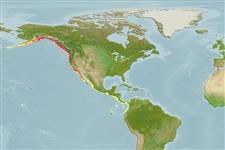>
Perciformes/Zoarcoidei (Eelpouts and pricklebacks) >
Zoarcidae (Eelpouts) > Lycodinae
Etymology: Lycodes: Greek, lykos = wolf + Greek, suffix, oides = similar to (Ref. 45335); pacificus: Named after the Pacific Ocean (Ref. 6885).
Environment: milieu / climate zone / depth range / distribution range
Ecologia
marino batidemersale; distribuzione batimetrica 9 - 399 m (Ref. 2850). Deep-water
Eastern Pacific: Gulf of Alaska to northern Baja California, Mexico.
Length at first maturity / Size / Peso / Age
Maturity: Lm ?, range 14 - ? cm
Max length : 46.0 cm TL maschio/sesso non determinato; (Ref. 2850); Età massima riportata: 5 anni (Ref. 6885)
Short description
Morfologia | Morfometria
Spine dorsali (totale): 0; Raggi dorsali molli (totale): 90-107; Spine anali 0; Raggi anali molli: 70 - 90. Caudal sharply rounded but not readily distinguishable from dorsal and anal fins. Pelvic fins minute.
Found on silty or sandy bottoms (Ref. 27436). Moves into shallow water at night to feed on marine worms, crustaceans, small bivalves, and brittle stars (Ref. 6885, 27436). Few live over 5 years (Ref. 6885). If used live as bait, it attracts large rockfishes, greenlings or codfishes (Ref. 27436). Flesh considered good but not esteemed (Ref. 27436).
Life cycle and mating behavior
Maturità | Riproduzione | Deposizione | Uova | Fecundity | Larve
Anderson, M.E., 1994. Systematics and osteology of the Zoarcidae (Teleostei: Perciformes). Ichthyol. Bull. J.L.B. Smith Inst. Ichthyol. 60:120 p. (Ref. 11954)
IUCN Red List Status (Ref. 130435)
Threat to humans
Harmless
Human uses
Pesca: pesca di sussistenza
Informazioni ulteriori
BibliografiaAcquacolturaProfilo di acquacolturaVarietàGeneticaElectrophoresesEreditarietàMalattieElaborazioneNutrientsMass conversion
CollaboratoriImmaginiStamps, Coins Misc.SuoniCiguateraVelocitàModalità di nuotoArea branchialeOtolithsCervelliVista
Strumenti
Special reports
Download XML
Fonti Internet
Estimates based on models
Preferred temperature (Ref.
123201): 5.3 - 9.4, mean 6.8 °C (based on 123 cells).
Phylogenetic diversity index (Ref.
82804): PD
50 = 0.5000 [Uniqueness, from 0.5 = low to 2.0 = high].
Bayesian length-weight: a=0.00263 (0.00137 - 0.00504), b=3.22 (3.06 - 3.38), in cm total length, based on LWR estimates for this Genus-body shape (Ref.
93245).
Trophic level (Ref.
69278): 3.3 ±0.43 se; based on food items.
Generation time: 3.5 ( na - na) years. Estimated as median ln(3)/K based on 1
growth studies.
Resilienza (Ref.
120179): Basso, tempo minimo di raddoppiamento della popolazione 4.5 - 14 anni (Ave. Fec=30).
Fishing Vulnerability (Ref.
59153): Moderate to high vulnerability (47 of 100).
